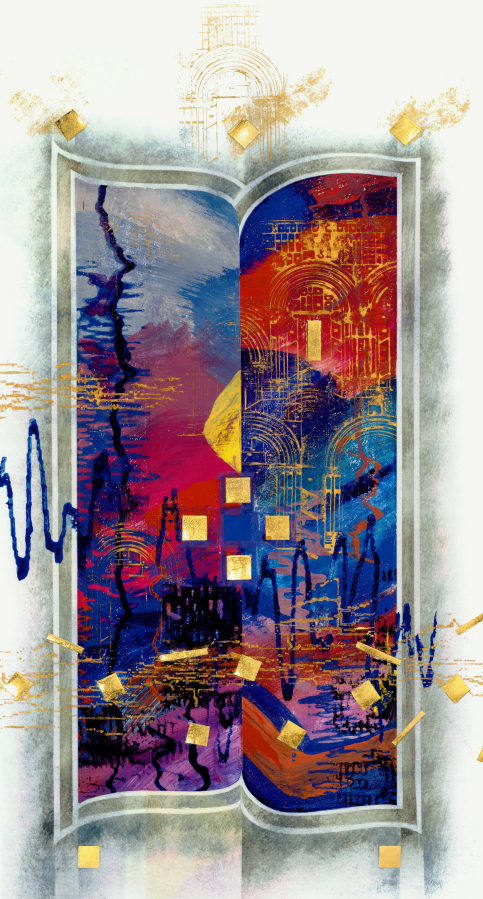ST. LOUIS — The image glows 30 feet away. Up close, its gold embellishment is meant to awe, and reflect, an onlooker.
Using techniques hundreds of years old, a handmade Bible brings an ancient artistic tradition into the 21st century. Although created with swan quills, vellum and soot ink, it also uses images of DNA, soundwaves and at least one photo taken by satellite.
Medieval illuminated manuscripts absorbed DNA from the anonymous monks and others who made them. Hundreds of years ago, those scribes knew nothing of genetic codes. For the St. John’s Bible, completed in 2011, a modern artist understands that his fingers and even spit have left a scientific mark. (What self-respecting artist doesn’t use spit occasionally?)
Classic materials combine with modern imagery in the St. John’s Bible, a 15-year project that involved 23 artists and an undisclosed amount of money.
“We’d never do it again,” says Tim Ternes, who has the unique job of director of the Bible project. But all involved are proud of the Bible, which is more than 1,100 pages and kept in a climate-controlled space at Hill Museum & Manuscript Library at St. John’s University in Collegeville, Minn.
A fine art copy has come to St. Louis, on loan to the Archdiocese of St. Louis, which hopes to buy it. The price of the reproduction is better known: about $150,000.
At least one hand-bound volume (not the whole Bible) will make its way around the city during the year. For instance, in May it will be at Mercy Hospital in Creve Coeur. In July, the Bible volume (Gospels & Acts) moves to the Cathedral Basilica, which will also sell more affordable books, cards and other mementos.
Ternes spoke to archdiocesan staff at the Cardinal Rigali Center who eagerly took in the exquisite artwork and discussed images that evoked Scripture. And not just Scripture, but popular culture, as the director points out in connection to stories of creation and Adam and Eve.
Adam and Eve for the 21st century don’t look anything like the blue-eyed blondes in Minnesota, Ternes says, getting a laugh. In this image, they appear African, with a coral-type snake in vivid attendance. For a Nativity scene, the shepherds are women and girls, which was “probably the case at the time of Christ,” accompanying information says. On a page depicting Christ’s genealogy, the form of a menorah is used, with names in both English and Hebrew (the Egyptian Hagar is also written in Arabic, invoking all three Abrahamic religions).
Surprising many, Ternes told guests they could turn the pages as long as their hands were washed. Gloves are forbidden because wearers are more likely to bend pages trying to get a grip on the paper, he says.
He reinforces his main message about the Bible: “It is communal, meant to be used and shared.”
Historic predecessors
The St. John’s Bible was the brainchild of a Welsh calligrapher, Donald Jackson, who had copied manuscripts since he was a boy. He is a scribe to Queen Elizabeth II and the House of Lords, creating official state documents.
In 1995, he approached St. John’s about the idea to create the first illuminated, handmade Bible in some 500 years. Money was raised from donors, and the commission began in 1998.
Roman Catholic monks, nuns and scholars at St. John’s brainstormed and discussed images for the new Bible while its layout was made by computer (so scribes knew in advance the first and last words of each page). It was decided to use the New Revised Standard Version translation, which is accepted by most Christian churches around the globe, Ternes says. Episcopal, Protestant and Jewish advisers were consulted.
Calligrapher Jackson did not put the first words down on paper until 2000.
The monks at St. John’s are Benedictines, who have a long history with education and copying manuscripts. Benedict of Nursia established a monastery in Monte Cassino, Italy, about 529. By about the 10th century, it had a famous scriptorium in which books from other nations were translated and copied in Latin.
Through the Middle Ages, books of calligraphy, primarily religious, became increasingly gilded with bright colors and gold leaf, indicative of the divine. These works of art survived the centuries more than paintings from the time did, and so they provide scholars with knowledge of art trends.
According to Fine Books & Collections magazine, illuminated manuscripts are among the splendors of Western civilization: “The volumes are embellished with illustrations called miniatures, deriving from two Latin words: mini?re, to color with red lead, and miniare, to illuminate. Strictly speaking, only illustrations completed with gold or silver paint elevate the work to ‘illuminated’ status, but today, most hand-decorated books are commonly referred to as such by scholars and collectors.”
In St. Louis, several libraries have antique illuminated manuscripts, especially individual leaves or pages. Among them are more than 60 separate items at St. Louis University, 10 Books of Hours at Washington University, an early Quran and Renaissance manuscripts at the Mercantile Library, more than 20 items at St. Louis Public Library, and, of course, pieces at the St. Louis Art Museum.
These are usually kept in rare books collections, brought out for special exhibits or requests.
Like those books, the St. John’s Bible is expected to last for centuries.



